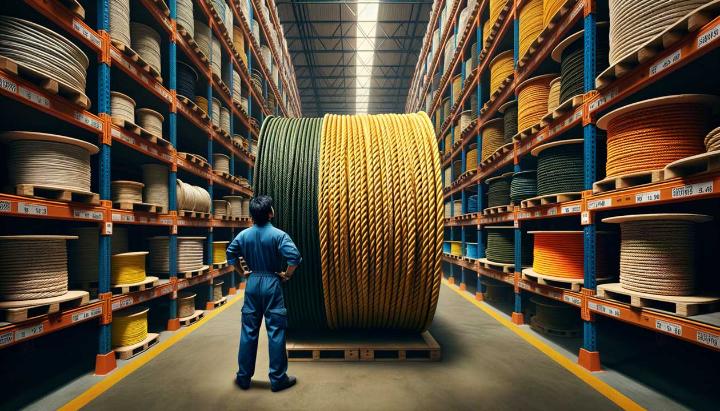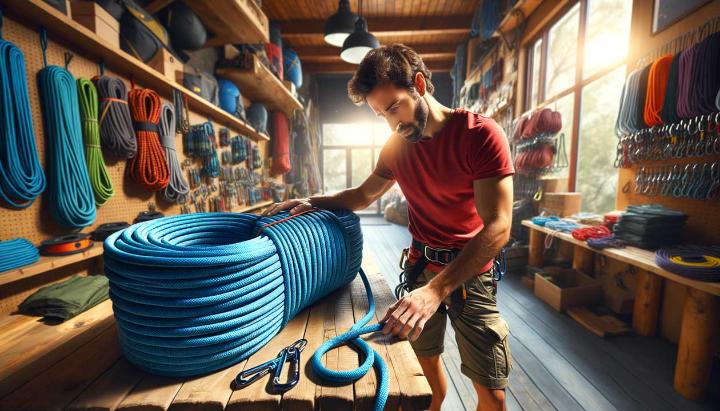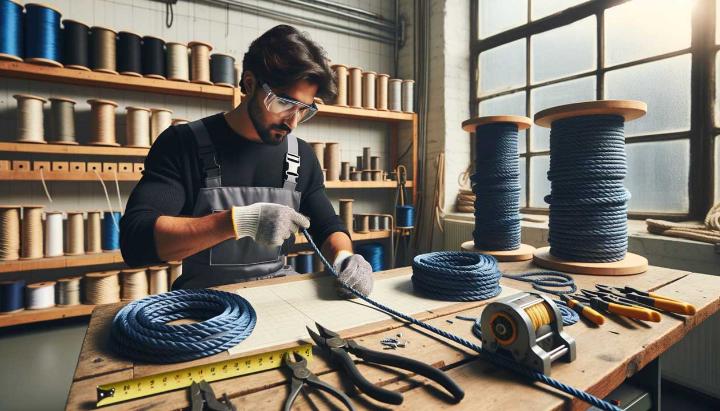Have you ever found yourself in a pickle, desperately wishing for just a few more metres of rope? Whether you're a seasoned professional or a DIY enthusiast, choosing between a 200 foot rope and a 300 foot rope can be a real head-scratcher. But fear not, because iRopes has got you covered!
In the world of ropes, size really does matter. The difference between 200 and 300 feet might seem trivial, but it can make or break your project. That's why we're diving deep into the nitty-gritty of rope length selection, exploring the pros and cons of each option, and revealing how iRopes' custom solutions can be your secret weapon.
From compatibility with a winch with 200 ft of cable to the extra flexibility offered by a 300 foot rope, we'll unravel the mysteries of rope length and help you make the perfect choice. Plus, we'll let you in on a little secret: at iRopes, we can cut ropes to any length you need, whether it's 200ft, 300ft, or anything in between.
So, grab a cuppa and get ready to learn why choosing the right rope length is crucial for your success. Trust us, by the end of this post, you'll be a rope length guru, ready to tackle any project with confidence!
Factors to Consider When Selecting Rope Length
Choosing the right rope length is crucial for any project, whether you're scaling a cliff face or securing a heavy load. Let's dive into the key factors that will help you make an informed decision.
Load Characteristics and Intended Use
When I first started working with ropes, I quickly learned that one size doesn't fit all. The weight and shape of your load significantly impact the length of rope you'll need. For instance, a compact, heavy object might require less rope than a bulky, lightweight item.
Consider these questions:
- What's the primary purpose of your rope? Are you using it for climbing, hauling, or securing equipment?
- How heavy is your typical load? Heavier loads may require longer ropes for added safety and maneuverability.
- What's the shape of your load? Awkward or large shapes might need extra rope length for proper securing.
Rope Diameter and Material Selection
The diameter of your rope plays a crucial role in its strength and abrasion resistance. Generally, thicker ropes are stronger but less flexible. When selecting rope length, consider how the diameter might affect your ability to handle and store the rope.

Material choice is equally important. Different materials offer varying levels of stretch, durability, and resistance to environmental factors. Here's a quick comparison:
- Nylon: Excellent for dynamic loads, high stretch, good for climbing ropes.
- Polyester: Low stretch, UV resistant, ideal for static applications.
- Polypropylene: Lightweight, floats on water, suitable for marine use.
Remember, the material you choose can affect how much rope you need. For example, a nylon rope might require more length to account for its stretch factor.
Have you considered how environmental factors might impact your rope choice? Extreme temperatures, moisture, and UV exposure can all affect rope performance and longevity. Always factor in these conditions when determining your optimal rope length.
By carefully considering load characteristics, intended use, rope diameter, and material, you'll be well-equipped to select the perfect rope length for your needs. Don't hesitate to consult with rope specialists for personalized advice – after all, the right rope can make all the difference in your project's success and safety.
Advantages of a 200-Foot Rope: Versatility and Safety
When it comes to choosing the right rope length for your projects, a 200-foot rope offers a sweet spot of versatility and practicality. I've found that this length strikes an excellent balance between reach and manageability, making it a go-to choice for many professionals and DIY enthusiasts alike.
Strength and Durability of Long Ropes
One of the key advantages of a 200-foot rope is its impressive strength-to-length ratio. In my experience working with various rope lengths, I've noticed that longer ropes like the 200-footer tend to distribute load more evenly, reducing wear and tear on specific sections. This translates to increased durability and a longer lifespan for your rope.
- Enhanced load distribution: The extra length allows for better weight distribution, reducing stress on any single point.
- Improved abrasion resistance: With more rope to work with, you can alternate contact points, minimizing wear in high-friction areas.
- Versatile material options: 200-foot ropes are available in various materials, each offering unique benefits. For instance, nylon ropes provide excellent stretch and shock absorption, while polyester ropes offer superior UV and weather resistance.

Applications for 200-Foot Ropes in Various Industries
The versatility of a 200-foot rope shines through in its wide range of applications across different industries. Here are some practical uses I've encountered:
- Construction and maintenance: Perfect for creating vertical lifelines on multi-story buildings or setting up temporary safety systems.
- Rescue operations: Provides ample length for complex rescue scenarios, offering safety and flexibility in challenging environments.
- Outdoor adventures: Ideal for rock climbing, canyoneering, or setting up ziplines, giving you plenty of rope to work with in diverse terrains.
One of the standout features of a 200-foot rope is its compatibility with standard winches. Many winches come with 200 ft of cable, making this rope length a natural fit for winching operations. This compatibility can be a game-changer in situations where you need to seamlessly integrate your rope with mechanical assistance.
Have you ever found yourself wishing for just a bit more rope during a project? With a 200-foot rope, those moments become far less frequent. It provides that extra buffer for safety and maneuverability without becoming unwieldy to handle or store.
Remember, while a 200-foot rope offers numerous advantages, it's essential to assess your specific needs and consult with rope specialists to ensure you're making the best choice for your applications. At iRopes, we're always here to help you find the perfect rope solution, whether it's a standard 200-foot length or a custom-cut rope tailored to your unique requirements.
Benefits of a 300-Foot Rope: Versatility and Applications
When it comes to rope selection, bigger isn't always better - but in the case of a 300-foot rope, the extra length can be a game-changer. I've spent years working with ropes of various lengths, and I can tell you firsthand that a 300-footer opens up a world of possibilities.
Strength and Durability of 300-Foot Ropes
One of the most impressive aspects of a 300-foot rope is its strength-to-weight ratio. These longer ropes are often constructed using advanced materials and techniques that enhance their durability and load-bearing capacity.
- Double braided construction: Many 300-foot ropes feature a double braided design, combining superior strength with flexibility. This construction allows for a breaking load ranging from 7,800 to 16,000 lbs, depending on the material and diameter.
- Material options: Nylon ropes offer excellent stretch and shock absorption, while composite ropes blend strength with UV and chemical resistance. The choice of material can significantly impact the rope's performance in different environments.
- Extended lifespan: With proper care, a high-quality 300-foot rope can last for years, making it a cost-effective investment for professionals and serious enthusiasts alike.

Practical Uses for 300-Foot Ropes in Various Industries
The versatility of a 300-foot rope truly shines when you consider its applications across different sectors. Here are some real-world examples I've encountered:
- Construction: On high-rise building sites, 300-foot ropes are essential for securing equipment and creating safety lines for workers at extreme heights.
- Marine operations: In ports and on large vessels, these ropes are crucial for mooring ships and handling heavy cargo. The extra length provides flexibility in tidal conditions and varying dock sizes.
- Search and rescue: During complex rescue operations in mountainous or coastal areas, a 300-foot rope can mean the difference between reaching a stranded individual or falling short.
As John Smith, a veteran search and rescue coordinator, once told me, "In our line of work, having that extra 100 feet of rope isn't just convenient - it can be lifesaving. It gives us the reach we need in situations where every inch counts."
Have you ever found yourself in a situation where a standard 200-foot rope just wasn't quite long enough? That's where the 300-footer really proves its worth. It provides that extra margin of safety and flexibility that can make all the difference in challenging environments.
Remember, while a 300-foot rope offers numerous advantages, it's essential to consider your specific needs and storage capabilities. At iRopes, we understand that one size doesn't fit all, which is why we offer custom cutting services to ensure you get the perfect length for your unique requirements.
iRopes' Custom Rope Length Solutions
When it comes to rope selection, one size definitely doesn't fit all. That's where iRopes' custom rope length solutions come into play. As someone who's worked with ropes in various industries for over a decade, I can't stress enough how crucial it is to have the right length for your specific needs.
Customizing Your Perfect Rope
At iRopes, we understand that every project is unique. That's why we offer a range of customization options to ensure you get the perfect rope for your requirements. Let me walk you through the process:
- Diameter selection: We offer ropes from thin, lightweight options to hefty 2-inch diameter ropes, catering to a wide range of load capacities and applications. Learn more about our high-quality 2 and 3-inch thick ropes.
- Material choice: From durable nylon to UV-resistant polyester, we help you select the material that best suits your environment and usage. For specialized needs, see our customized 2-inch boat rope reel.
- Color customization: Whether for safety, branding, or personal preference, we can provide ropes in various colors to meet your needs.
But it doesn't stop there. Our professional splicing services ensure that your custom rope is finished to the highest standards, guaranteeing optimal performance and longevity.

Measuring and Calculating Rope Length
Determining the right rope length is both an art and a science. Here's a step-by-step guide to help you get it right:
- Identify your application: Are you setting up a winch system, creating a safety line, or rigging for a specific task?
- Measure the working distance: Use a tape measure to get an accurate reading of the required length.
- Account for safety margins: Add extra length for knots, splices, and safety factors - typically 10-20% of the total length.
- Consider stretch factors: Different materials have varying stretch rates. For nylon ropes, add an additional 10-15% to account for elongation under load.
Pro tip: When in doubt, it's always better to err on the side of a slightly longer rope. You can always shorten a rope, but lengthening one is significantly more challenging!
Have you ever found yourself in a situation where you wished you had just a few more feet of rope? With iRopes' custom solutions, those days are over. We can cut ropes to precise lengths - whether you need 200 feet, 300 feet, or any specific measurement in between or beyond.
Remember, the right rope length isn't just about convenience; it's about safety and efficiency. By choosing a custom rope length from iRopes, you're investing in a solution that's tailored to your exact needs, ensuring optimal performance and peace of mind.
Ready to find your perfect rope? Reach out to our team of experts, and we'll guide you through the process, helping you select the ideal length, material, and specifications for your unique requirements. With iRopes, you're not just buying a rope; you're investing in a customized solution that's built to last. For more information, check out our page on customization.
Find Your Ideal Rope Length
Choosing the right rope length, whether a 200 foot rope or a 300 foot rope, can significantly impact your project's success. A 200-foot rope is ideal for most residential applications and remains compatible with a standard winch with 200 ft of cable. On the other hand, a 300-foot rope is perfect for larger projects requiring extended reach and flexibility. At iRopes, we provide custom rope length solutions to match your specific needs, ensuring optimal performance and safety. Don't hesitate to fill out the inquiry form above to discover how iRopes can tailor a solution to your requirements.